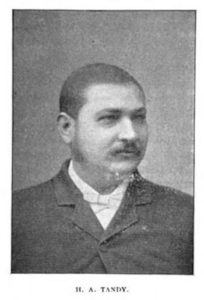
Henry A. Tandy
*The birth of Henry A. Tandy is celebrated on this date in c. 1853. He was a Black building contractor and entrepreneur specializing in decorative stone masonry and brickwork.
Born enslaved in Estill County, KY, Tandy moved to Lexington, KY, after the American Civil War. In Lexington, 1867, he first worked for local photographer John Mullen. However, Tandy found his lifelong success through the building and contracting firm of Garrett D. Wilgus. There, he began as one of over 200 employees and was promoted to foreman in 1892. Tandy and Albert Byrd, his future business partner, ran the company in the 1880s as Wilgus's health declined.
After Wilgus died in 1893, the two established Tandy & Byrd, where Tandy was the business manager and the face of the business, and Byrd was the foreman. By 1894, the firm employed about 50 Black and white workers. The Lexington Opera House, on the National Register of Historic Places, was among the firm's projects. Other notable projects of the firm are the 1894 First National Bank building; the Carnegie Center for Literacy and Learning; the Natural Science Building at the State College, now known as Miller Hall at the University of Kentucky; original structures at Eastern Kentucky University, Roark Hall, and Sullivan Hall.
He was also responsible for the grand Richardsonian Romanesque courthouse, which features a dome structure, arches, and artistic features incorporated into the stonework. One of the largest courthouses in the U.S. was completed in 1898. An example of adaptive reuse is that the building now houses the Lexington Visitor Center and several restaurants.
Handy presented papers and spoke at the National Negro Business League on contracting and building. He married Emma Brice, born in 1855. The couple's son, Vertner Woodson Tandy, became the first African American architect in New York. He was active in church and Sunday school work in the Historic St. Paul African Methodist Episcopal Church and the Masonic Order. The historic Lexington, KY, Fayette County Courthouse is his most known legacy. By the early 20th century, he was among the wealthiest African Americans in Kentucky.
Henry A. Tandy died of a septic infection on February 13, 1918, and was buried in Greenwood Cemetery, later named Cove Haven Cemetery. In 2020, downtown Cheapside Park, adjacent to the courthouse, was renamed the Henry A. Tandy, Centennial Park.